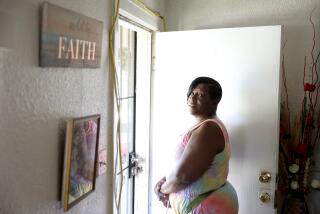Day-Care Providers Say State Reimbursements Fail to Pay Living Wage
- Share via
In her 24 years as a licensed day-care provider, Martha Sabbs says, she has never had less than a full day.
She picks up several of her seven charges from their homes or schools. She makes them meals and helps them with their homework. She took out a loan to build an addition to her home where the children can play and learn.
It seems like full-time work to her, and yet when she adds up her state-reimbursed wages at the end of the day, she says her hourly rate hovers somewhere between $2 or $3. She is not alone. Family day-care operators who provide subsidized care for the children of welfare recipients have long complained that they make less than the minimum wage and are not reimbursed in a timely fashion.
On Thursday, 40 such care providers and supporters with the advocacy group ACORN--Assn. of Community Organizations for Reform Now--descended on the downtown Los Angeles offices of the state labor commissioner to file wage claims and demand that labor authorities investigate the state and county for alleged violation of minimum wage laws.
“I’ve put my heart and soul into this, taken out loans I can’t hardly pay back, and I still have to fight to get paid,” said Sabbs, a South Los Angeles provider.
The issue has assumed critical importance in the last few years because welfare reform laws require most recipients to find jobs and guarantees them subsidized child care. About 4,800 day-care homes are licensed to provide subsidized services in Los Angeles County.
The state sets rates for subsidized care each year based on a regional analysis of what some other subsidized and non-subsidized child care providers are paid. Rates vary depending on the age of the child and whether the care is full time or part time.
State child care funds are funneled to the Los Angeles County welfare office to pay providers, who must present vouchers for the number of hours they work. But critics say the rates grossly shortchange the providers and potentially harm the well-being of children.
Under current guidelines, for example, a licensed day-care provider who provides full-time care for a 6-year-old is reimbursed at an hourly rate of $3.57, up to a maximum of $527 monthly. The full-time hourly rate for a child 2 to 5 years old is $3.25, with a maximum payout of $555 monthly.
Child care providers want the state to guarantee a living wage or at least California’s minimum hourly wage of $5.75.
“It’s such a pitiful state right now,” said Yuan Chen, a Legal Aid attorney who did not participate in the demonstration but is working with providers. “It’s also ironic because the state and county [have] been encouraging welfare recipients to get jobs as child care providers and look at what they are paying them.”
County officials said that they too are concerned but that their hands are tied.
“Our concern is to ensure that we keep quality providers,” said child care program director Pearlene Saffold. “We have been in dialogue with the state about the rates and would like providers to be compensated at a decent living wage.”
But state officials said that changing the rates would require action by the Legislature.
“We are required to pay subsidized providers the same rate that the general public pays for their non-subsidized care,” said Jo Weber, branch chief of the welfare-to-work division in the state Department of Social Services.”
Weber said the rates allow for most providers to make the equivalent of the minimum wage and more.
But Sabbs and other providers say it is hard to furnish quality care at such low wages. She says she does not bring enough to hire an attendant and relies on her 19-year-old daughter to help care for the children without pay.
“She does the pickups for me and I let her use my van,” Sabbs said. “She does a great job, but if I made at least the minimum wage, I could afford to pay my bills and hire someone.”
More to Read
Inside the business of entertainment
The Wide Shot brings you news, analysis and insights on everything from streaming wars to production — and what it all means for the future.
You may occasionally receive promotional content from the Los Angeles Times.











